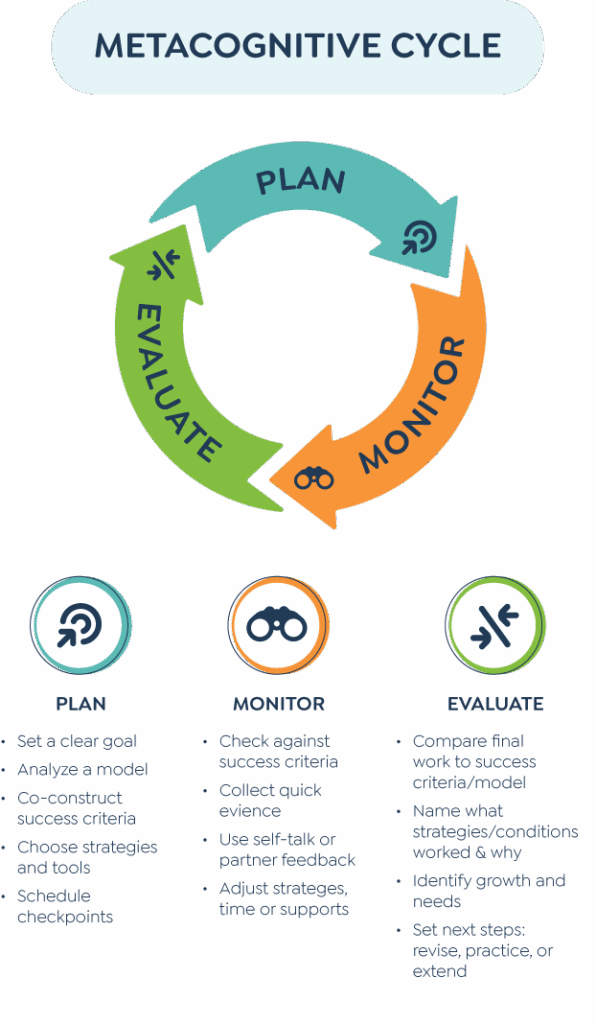💡 Why This Model?
Learning, like music, is both science and art.
When we teach, we are conducting a symphony of attention, practice, and feedback — every learner bringing their own rhythm, tone, and phrasing.
Dr. Paul J. Bloomberg, a saxophonist with a Master’s in Music Performance, and Isaac Wells, a lifelong musician and multi-instrumentalist (percussion, flute, and vocals), designed this model through the lens of musicianship. Just as musicians rehearse deliberately—listening, adjusting, and repeating until performance becomes expressive—learners also need structured cycles of practice, feedback, and reflection to master complex skills.
Practice doesn’t make perfect; deliberate practice makes it purposeful.”
This model builds upon the clarity of Madeline Hunter’s Mastery Teaching, the apprenticeship framework of Pearson & Gallagher’s Gradual Release (1983, UC Berkeley), and the structure of Fisher & Frey (2008)—then evolves them through Deliberate Practice, the Metacognitive Cycle, and Skill–Will–Thrill. As explored in Chapter 8 of Amplify Learner Voice through Culturally Responsive and Sustaining Assessment (2023), deliberate cycles of reflection and adjustment cultivate learner agency by making thinking visible and actionable and engaging within a community of feedback.
The result is a culturally responsive framework grounded in rhythm, belonging, and agency. It invites teachers and learners to engage in coordinated rehearsal—planning, monitoring, evaluating, and adjusting together until both teaching and learning become artful, not mechanical.
We don’t just release responsibility; we improvise it. Learning, like jazz, thrives on collaboration, feedback, and freedom within form.”
🧠 The Metacognitive Cycle at the Core
At the heart of this framework is the Metacognitive Cycle:
Plan → Monitor → Evaluate → Adjust.
Like musicians tuning, rehearsing, and refining a piece, students learn to think about their thinking—noticing dissonance, making micro-adjustments, and iterating toward clarity.
Each instructional phase uses this cycle to build both cognitive precision and learner identity. Teachers model the metacognitive process aloud, and students internalize it through repeated cycles of deliberate practice.
Skill–Will–Thrill: The Motivation Behind the Music
| Element | Focus | In Practice |
| Skill | Clarity and precision. | Learners see, name, and practice what quality looks and sounds like—much like musicians studying tone, rhythm, and phrasing. |
| Will | Belonging and persistence. | Students rehearse and revise within a supportive ensemble of peers, building confidence through feedback and shared rhythm. |
| Thrill | Purpose and joy. | Learners connect growth to identity and performance, feeling the satisfaction of improvement and creative expression. |
The Coaching Cycle: From Woodshedding to Performance
Each phase of this cycle mirrors the musical process—from listening to masters, rehearsing with ensemble support, practicing in the woodshed, and finally, performing with purpose. Teachers act as conductors, section leaders, and coaches, guiding students through progressive levels of mastery while embedding the metacognitive cycle (Plan → Monitor → Evaluate → Adjust) throughout.
🎧 PHASE 0: Immersion & Co-Construction of Quality — Listening to the Masters
Purpose: To help learners internalize quality by studying and constructing examples together, just as musicians transcribe, imitate, and analyze recordings.
| Looks Like | Feels Like | Sounds Like |
| Teacher curates multiple exemplars (recordings, texts, visuals) and facilitates side-by-side comparison. | Curious, inspired, and focused. | “What do all these examples have in common?” |
| Students co-construct a model, naming moves that make work excellent. | Safe to experiment and notice details. | “Let’s build one together.” |
| Learners describe success criteria using their own words. | Confidence builds through clarity. | “I can hear and see what quality sounds like.” |
🧭 Metacognitive Move: Plan → “What makes this version strong? What will I aim for in my performance?”
🥁 PHASE 1: Guided Rehearsal — I Do With You (Sectionals)
Purpose: To model cognitive moves and build precision through guided repetition, much like practicing scales or rhythm patterns in a sectional rehearsal.
| Looks Like | Feels Like | Sounds Like |
| Teacher performs a think-aloud; students echo steps, gestures, or phrasing. | Predictable, rhythmic, encouraging. | “Play it with me…” / “Watch how I count this measure.” |
| Feedback loops happen in real time. | Supported, focused, and musical. | “Let’s repeat that until it feels right.” |
| Accuracy before speed — repetition with reflection. | Confidence builds through mastery. | “What did you notice when we slowed it down?” |
🧭 Metacognitive Move: Monitor → “Am I staying in rhythm? What adjustments help me stay on tempo?”
🎷 PHASE 2: Collaborative Practice — We Do Together (Ensemble Work)
Purpose: To strengthen fluency and interdependence through peer collaboration, like a jazz combo finding groove through call-and-response.
| Looks Like | Feels Like | Sounds Like |
| Students work in small groups, applying strategies together, refining timing and tone. | Energetic, social, synchronized. | “How did you approach that passage?” / “Can you play that back?” |
| Teacher circulates, offering micro-feedback and encouraging improvisation. | Safe to try, fail, and recover. | “I like your phrasing; try varying the rhythm.” |
| Peers listen to one another and adjust. | Collective confidence and groove. | “That harmony worked—let’s keep that variation.” |
🧭 Metacognitive Move: Evaluate → “How did our ensemble sound? What improved when we listened to each other?”
🎼 PHASE 3: You Do With Coaching — Private Lessons, Peer Coaching & Woodshedding
Purpose: To empower learners to seek feedback, practice independently, and engage in peer or mentor coaching—similar to musicians taking private lessons, working with section leaders, or collaborating informally to refine their craft. Agency means not waiting for feedback but actively pursuing it.
| Looks Like | Feels Like | Sounds Like |
| Students practice individually or in small peer groups while seeking targeted feedback from teachers, mentors, or peers—like musicians refining passages together or taking a private lesson mid-rehearsal. | Intentional, self-directed, professional. | “Can you listen to my phrasing and tell me where it feels off?” |
| Learners invite critique and coaching when needed, using tools like exemplars, rubrics, or recordings. | Accountable, open, agentive. | “I asked Jordan to coach me through this section.” |
| Teachers and peers model feedback loops; the focus is improvement, not evaluation. | Safe, collaborative, energized. | “Let’s play that phrase again together until it clicks.” |
🧭 Metacognitive Move: Adjust → “Who can help me grow? What will I do with their feedback to improve my performance?”
🎤 PHASE 4: You Do for Transfer — The Performance
Purpose: To bring all practice together in an authentic performance—the “big game” where learners show mastery through improvisation and expression within structure.
| Looks Like | Feels Like | Sounds Like |
| Students present, perform, or publish work to real audiences. | Proud, expressive, energized. | “This is my take on the theme.” |
| Teacher observes, celebrates, and collects evidence of transfer. | Joyful and validating. | “Your tone and timing have really matured.” |
| Learners reflect on how rehearsal prepared them for the moment. | Agency and artistry meet. | “I improvised within the structure—it felt like my own.” |
🧭 Metacognitive Move: Reflect → “How did my preparation shape my performance? What did I learn from playing for others?”
🎧 PHASE 5: MetaCycle — Reflection & Re-Engagement (Listening Back)
Purpose: To listen back, review, and refine—much like a musician reviewing a recording to plan the next session.
| Looks Like | Feels Like | Sounds Like |
| Students review recordings, notes, or exemplars from their last cycle. | Reflective, analytical, calm. | “I heard where I lost tempo there—next time I’ll breathe earlier.” |
| Teacher facilitates goal setting based on observed strengths and gaps. | Empowered, clear, motivated. | “What’s our focus for the next rehearsal?” |
| Students set new goals and plan next steps. | Continuous improvement. | “I’m ready for the next set—let’s tighten the rhythm section.” |
🧭 Metacognitive Move: Plan → “Based on what I learned, how will I practice smarter next time?”
✨ How the MetaCycle Threads Through Every Phase
The MetaCycle (Plan → Monitor → Evaluate → Adjust) is not a final step—it is the tempo of learning that keeps every phase in rhythm. Each stage of deliberate practice uses one beat of the cycle to sustain reflection and agency.
| Phase | Metacognitive Focus | How It Sounds in Practice |
| Phase 0: Immersion — Listening to the Masters | Plan | Learners co-construct criteria, set goals, and envision success before playing a note: “What will quality sound like?” |
| Phase 1: Guided Rehearsal — Sectionals | Monitor | Students stay attuned to the process and check for rhythm and accuracy: “Am I on tempo and in sync?” |
| Phase 2: Collaborative Practice — Ensemble Work | Evaluate | Peers and teachers reflect together on tone, phrasing, and teamwork: “How did our ensemble sound? What’s improving?” |
| Phase 3: Coaching & Woodshedding | Adjust | Learners and coaches make micro-changes through private lessons or peer feedback: “What should I refine next?” |
| Phase 4: Performance | Evaluate → Adjust | After performing, students reflect and note where they will focus next: “What did I learn from playing for others?” |
| Phase 5: Reflection & Re-Engagement | Plan → Monitor → Evaluate → Adjust | The full cycle restarts with goal setting, reflection, and renewed practice. |
✨ Core Principles of the Coaching Cycle
| Principle | In Action |
| Metacognitive Cycle (Plan–Monitor–Evaluate–Adjust) | Modeled on musicians practicing, teachers and learners listen, refine, and adjust continuously. |
| Skill–Will–Thrill | Skill = technical mastery, Will = persistence through ensemble practice, Thrill = expressive joy of performance. |
| Immersion Before Instruction | Students study “master recordings” (exemplars) and co-construct quality before performing. |
| Deliberate Practice | Focused repetition with clear purpose and immediate feedback. |
| Feedback Literacy | Feedback is like rehearsal notes—actionable, specific, and part of the process. |
| Cultural Responsiveness | Learning honors rhythm, improvisation, and collaboration—rooted in musical culture. |
| Recursive MetaCycles | Each practice round refines tone, timing, and confidence—the learner becomes the artist. |
🎷 Teaching is conducting; learning is performance. Together, we create the rhythm of agency.
References
- Bloomberg, P. J., Vandas, K., Twyman, I., Dukes, V., Carrillo Fairchild, R., Hamilton, C., & Wells, I. (2023). Amplify learner voice through culturally responsive and sustaining assessment. Mimi & Todd Press.
- Fisher, D., & Frey, N. (2008). Better Learning Through Structured Teaching: A Framework for the Gradual Release of Responsibility. ASCD.
- Hunter, M. (1982). Mastery Teaching. El Segundo, CA: TIP Publications.
- Pearson, P. D., & Gallagher, M. C. (1983). The instruction of reading comprehension. Contemporary Educational Psychology, 8(3), 317–344.
- Ericsson, K. A., Krampe, R. T., & Tesch-Römer, C. (1993). The role of deliberate practice in the acquisition of expert performance. Psychological Review, 100(3), 363–406.




